instrument panel PONTIAC BONNEVILLE 1993 Owners Manual
[x] Cancel search | Manufacturer: PONTIAC, Model Year: 1993, Model line: BONNEVILLE, Model: PONTIAC BONNEVILLE 1993Pages: 322, PDF Size: 16.31 MB
Page 17 of 322
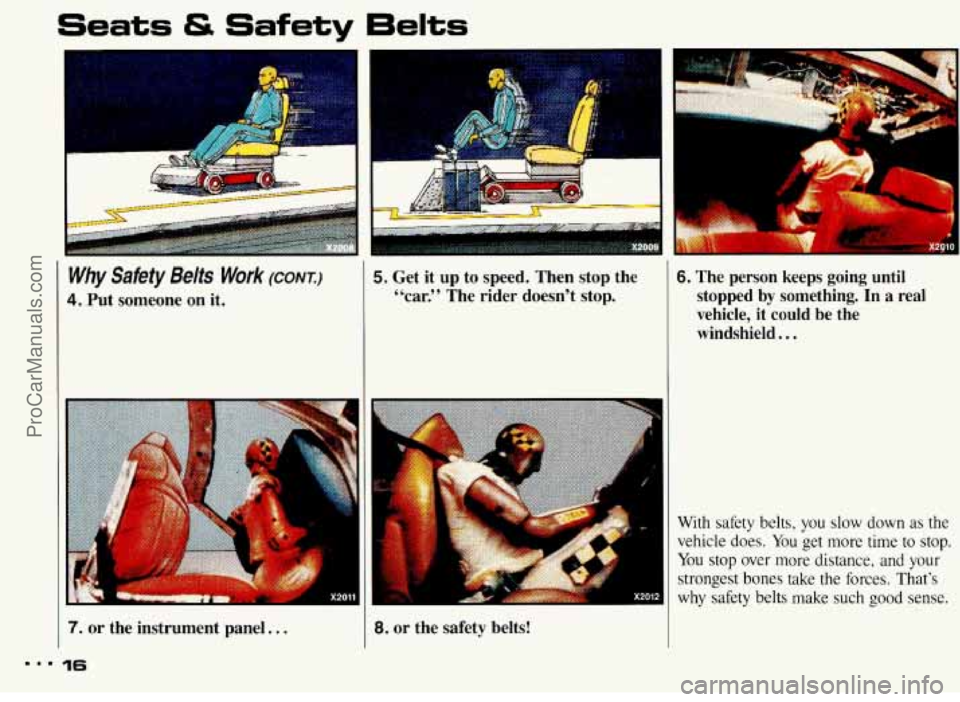
...
Seats & Safety Belts
Why Safety Belts Work (CONI)
4. Put someone on it.
7. or the instrument panel.. .
16
5. Get it up to speed. Then stop the
“car.” The rider doesn’t stop.
8. or the safety belts!
6. The person keeps going until
stopped by something. In
a real
vehicle,
it could be the
windshield..
.
With safety belts, you slow down as the
vehicle
does. You get more time to stop.
You stop over more distance, and your
strongest
bones take the forces. That’s
why safety belts make such good sense.
ProCarManuals.com
Page 24 of 322
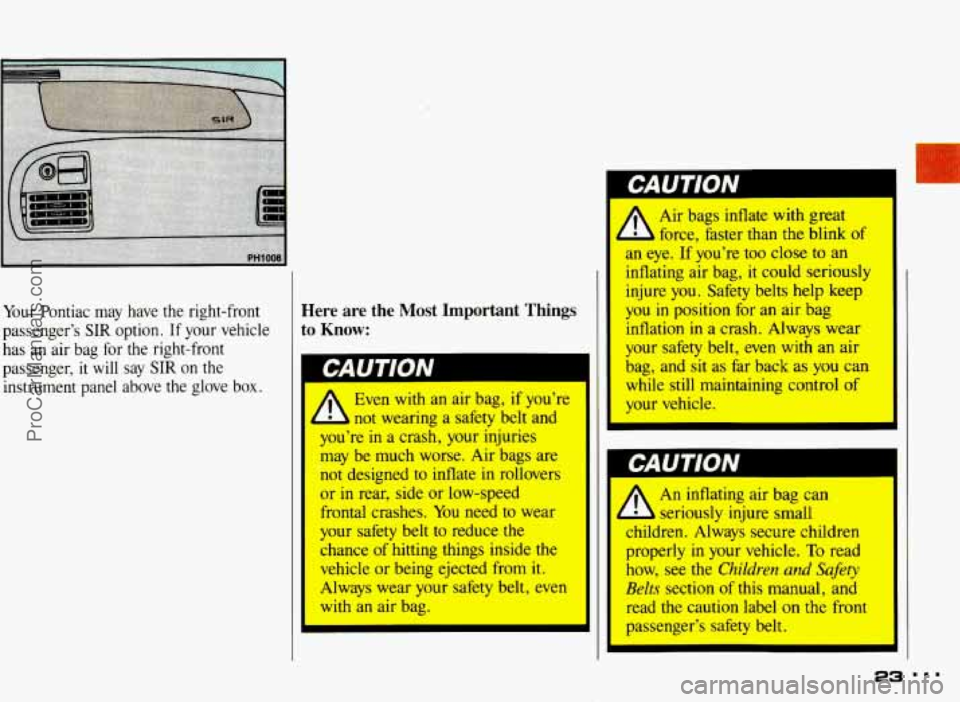
Your Pontiac may have the right-front
passenger’s
SIR option. If your vehicle
has an air bag for the right-front
passenger,
it will say SIR on the
instrument panel above the glove box.
Here are the Most Important Things
to Know:
Even with an air bag, if you’re
not wearing a safety belt and
Y
you.re in a crash, your injuries
may be much worse. Air bags are Air
bags inflate with great
force, faster than
the blink of
an eye. If you’re too close to an
inflating air bag, it could seriously
injure you. Safety belts
help keep
you in position for
an air bag
inflation
in a crash. Always wear
your safety belt, even with an air
bag, and sit as far back
as you can
while still maintaining control of
your vehicle.
“not designed to inflate in rollovers
or in rear, side or low-speed
frontal crashes. You need to wear
your safety belt
to reduce the
chance
of hitting things inside the
vehicle
or being ejected from it.
Always wear your safety belt, even
with an air bag.
A An inflating air bag can
children. Always secure children
properly in your vehicle.
To read
how, see the
Children and Safe9
Belts section of this manual, and
read the caution label
on the front
passenger’s safety belt.
- seriously injure small
ProCarManuals.com
Page 25 of 322
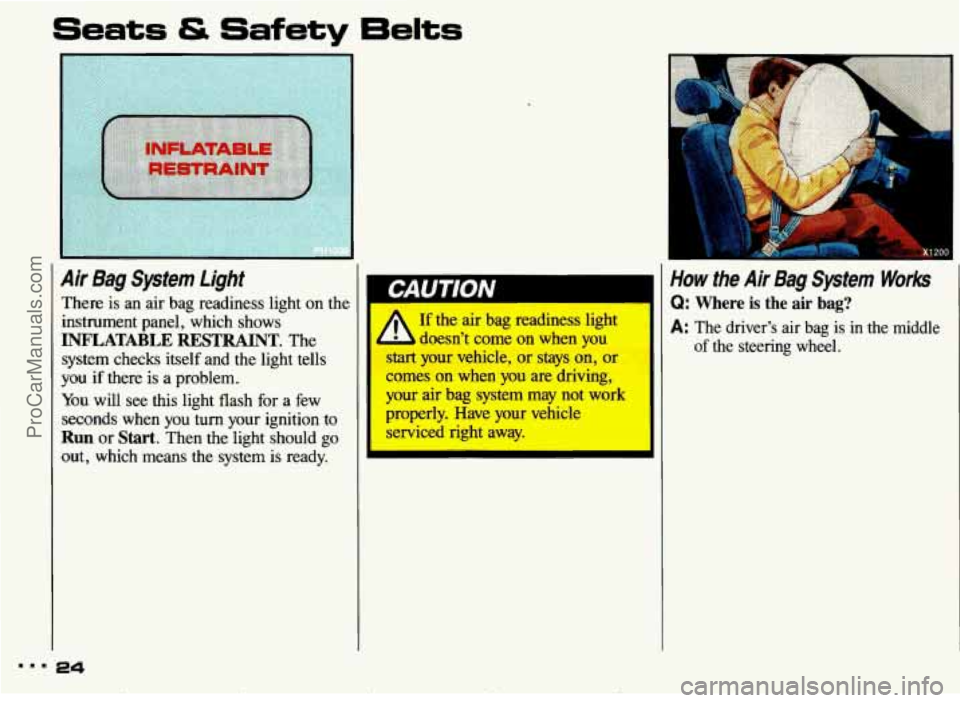
Seats & Safety 6elts
Air Bag System Light
There is an air bag readiness light on the
instrument panel, which shows
INFLATABLE RESTRAINT. The
system checks itself and the light tells
you if there is a problem.
You will see this light flash for a few
seconds when you turn your ignition to
Run or Start. Then the light should go
out, which means the system is ready.
If the air bag readiness light
L b doesn’t come on when you
s t your vehicle, or stays on, or
comes on when you are driving,
your air bag system may
not work
properly. Have your vehicle serviced right away.
4
3
How the Air Bag System Works
Q: Where is the air bag?
A: The driver’s air bag is in the middle
of the steering wheel.
ProCarManuals.com
Page 26 of 322
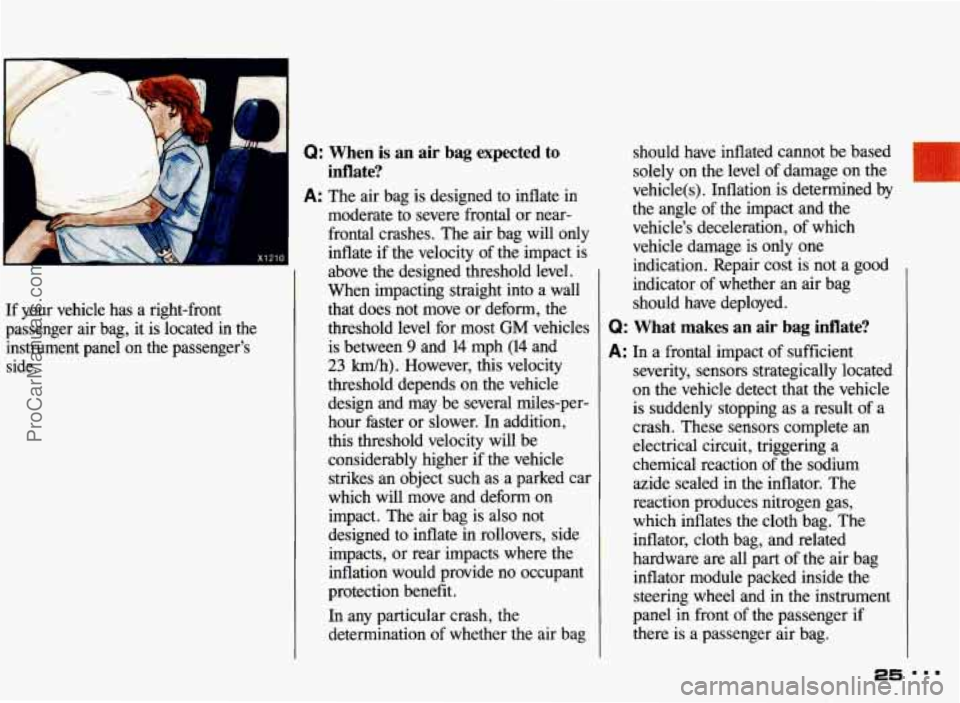
..
A
d Q: When is an air bag expected to
inflate?
A: The air bag is designed to inflate in
x1210 I
If your vehicle has a right-front
passenger air bag, it is located in the instrument panel on the passenger’s
side. moderate to severe
frontal or near-
frontal crashes. The air bag will only
inflate if the velocity
of the impact is
above the designed threshold level.
When impacting straight into a wall
that does not move or deform, the
threshold level for most
GM vehicles
is between
9 and 14 mph (14 and
23 km/h). However, this velocity
threshold depends on the vehicle
design and may be several miles-per-
hour faster or slower. In addition,
this threshold velocity will be
considerably higher
if the vehicle
strikes an object such as a parked car
which will move and deform on
impact. The air bag is also not
designed to inflate
in rollovers, side
impacts, or rear impacts where the
inflation would provide no occupant
protection benefit.
In any particular crash, the
determination of whether the air bag should
have inflated cannot be based
solely
on the level of damage on the
vehicle(s). Inflation is determined by
the angle of the impact and the
vehicle’s deceleration, of which
vehicle damage is
only one
indication. Repair cost is not a good
indicator of whether an air bag
should have deployed.
Q: What makes an air bag inflate?
A: In a frontal impact of sufficient
severity, sensors strategically located
on the vehicle detect that the vehicle
is suddenly stopping as
a result of a
crash. These sensors complete an
electrical circuit, triggering a
chemical reaction of the sodium
azide sealed in the inflator. The
reaction produces nitrogen gas,
which inflates the cloth bag. The
inflator, cloth bag, and related
hardware are all part of the air bag
inflator module packed inside the
steering wheel and in the instrument
panel in front of the passenger if
there is a passenger air bag.
26 DDD
ProCarManuals.com
Page 27 of 322
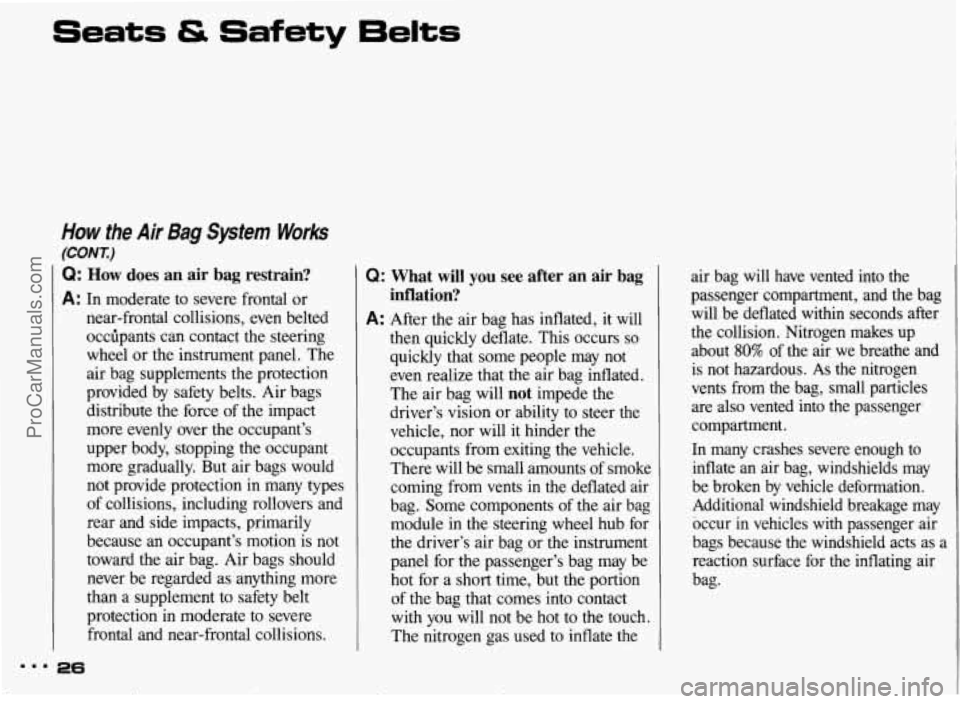
Seats & Safety Belts
How the Air Bag System Works
(CON X)
Q: How does an air bag restrain?
A: In moderate to severe frontal or
near-frontal collisions, even belted
occilpants can contact the steering
wheel or the instrument panel. The
air bag supplements the protection
provided by safety belts. Air bags
distribute the force
of the impact
more evenly over the occupant’s
upper body, stopping the occupant
more gradually. But air bags would
not provide protection
in many types
of collisions, including rollovers and
rear and side impacts, primarily
because an occupant’s motion is not
toward the air bag. Air bags should
never be regarded as anything more
than a supplement
to safety belt
protection in moderate to severe frontal and near-frontal collisions.
Q: What will you see after an air bag
inflation?
A: After the air bag has inflated, it will
then quickly deflate. This occurs
so
quickly that some people may not
even realize that the air bag inflated.
The air bag will
not impede the
driver’s vision or ability to steer the
vehicle, nor will it hinder the
occupants from exiting the vehicle.
There will be small amounts of smoke
coming from vents in the deflated air
bag. Some components of the air bag
module in the steering wheel hub for
the driver’s air bag or the instrument
panel for the passenger’s bag may be
hot for a short time, but the portion
of the bag that comes into contact
with
you will not be hot to the touch.
The nitrogen gas used to inflate the air
bag will have vented into the
passenger compartment, and
the bag
will be deflated within seconds after the collision. Nitrogen makes
up
about 80% of the air we breathe and
is not hazardous.
As the nitrogen
vents from the bag, small particles
are also vented into
the passenger
compartment.
In many crashes severe enough to
inflate an air bag, windshields may
be broken by vehicle deformation.
Additional windshield breakage may
occur in vehicles with passenger air
bags because the windshield acts as a
reaction surface for the inflating air
bag.
mm. 26
L ProCarManuals.com
Page 28 of 322
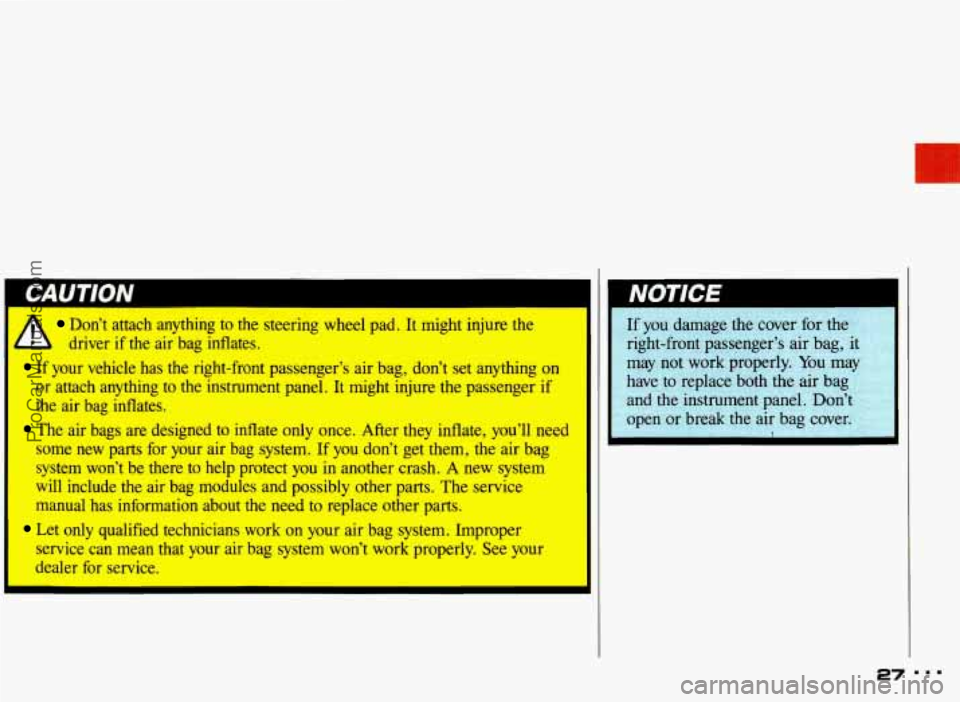
Don’t attach anything to the steering wheel pad. It might injure the
If your vehicle has the right-front passenger’s air bag, don’t set anything on
or attach anything to the instrument panel. It might injure the passenger if
the air bag inflates.
The air bags are designed to inflate only once. After they inflate, you’ll need
some new parts for your air bag system.
If you don’t get them, the air bag
system won’t be there
to help protect you in another crash. A new system
will include the air bag modules and possibly other parts. The service
manual has information about the need to replace other parts.
Let only qualified technicians work on your air bag system. Improper
service can mean that your air bag system won’t work properly.
See your
dealer
for service.
b driver if the air bag inflates.
If you damage the cover for the
right-front passenger’s air bag, it
may not work properly.
You may
have to replace both the air bag
and the instrument panel. Don’t
open or break the air bag cover.
7
27
ProCarManuals.com
Page 30 of 322
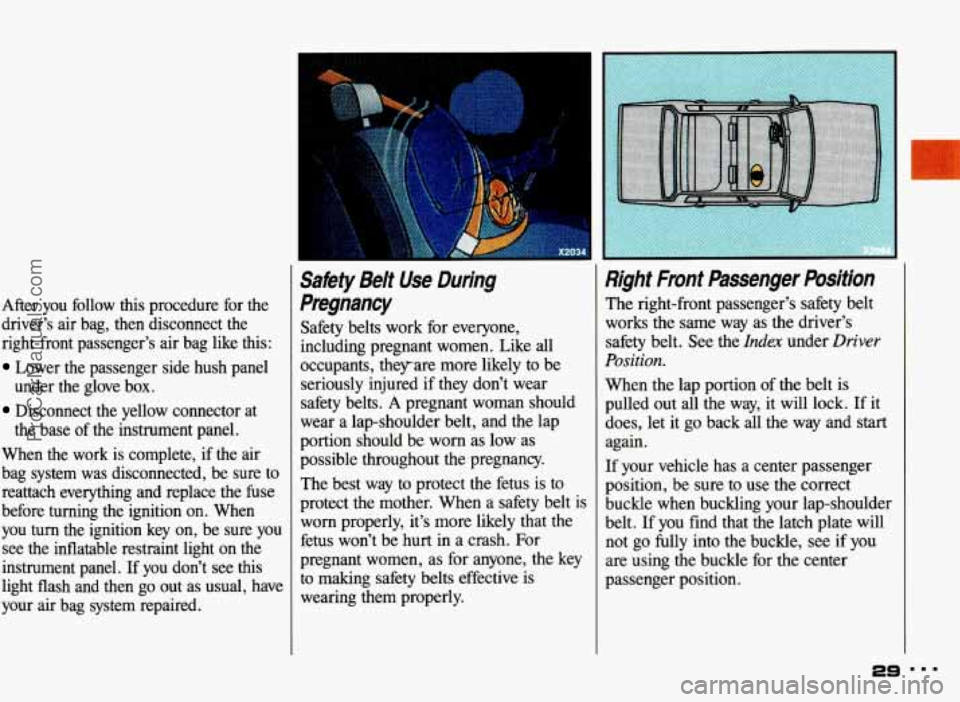
After you follow this procedure for the
driver’s air bag, then disconnect the
right-front passenger’s air bag like this:
Lower the passenger side hush panel
under the glove box.
Disconnect the yellow connector at
the base of
the instrument panel.
When the work is complete, if the air
bag system was disconnected, be sure
to
reattach everything and replace the fuse
before turning the ignition on. When
you turn
the ignition key on, be sure you
see the inflatable restraint light on
the
instrument panel. If you don’t see this
light flash and then go out as usual, have
your air bag system repaired.
..
Safety Belt Use During
Pregnancy
Safety belts work for everyone,
including pregnant women. Like all
occupants, they-are more likely to be seriously injured if they don’t wear
safety belts.
A pregnant woman should
wear a lap-shoulder belt, and the lap
portion should be
worn as low as
possible throughout the pregnancy.
The best way to protect the fetus is to
protect the mother. When a safety belt is
worn properly, it’s more likely that
the
fetus won’t be hurt in a crash. For
pregnant women, as for anyone, the key
to making safety belts effective is
wearing them properly.
Right Front Passenger Position
The right-front passenger’s safety belt
works the same way as the driver’s
safety belt. See the
Index under Driver
Position.
When the lap portion of the belt is
pulled out all the way, it will lock. If it
does, let it go back all the way and start
again.
If your vehicle has a center passenger
position, be sure to use the correct
buckle when buckling your lap-shoulder
belt. If you find that the latch plate will
not go fully into the buckle, see if you
are using the buckle for the center
passenger position.
29
ProCarManuals.com
Page 46 of 322
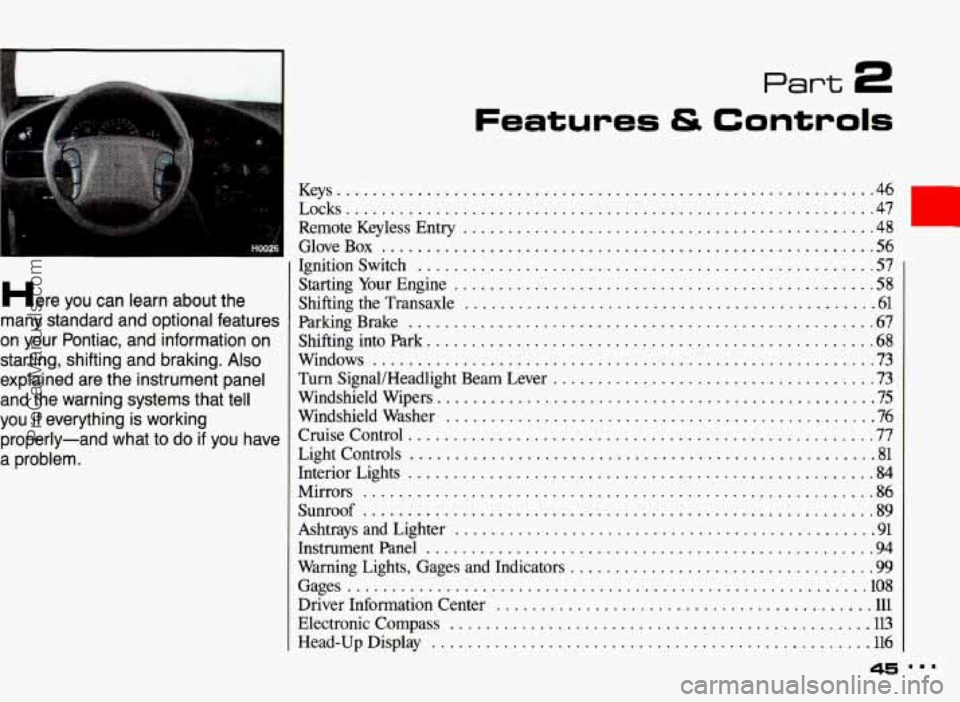
... Part 2
Features & Controls
Here you can learn about the
many standard and optional features
on your Pontiac. and information on
starting. shifting and braking
. Also
explained are the instrument panel
and the warning systems that tell
you
if everything is working
properly-and what to do
if you have
a problem
.
Keys ............................................................ 46
Locks
........................................................... 47
Remote Keyless Entry
.............................................. 48
GloveBox
....................................................... 56
Ignitionswitch ................................................... 57
StartingYourEngine
............................................... 58
Shifting the Transaxle
............................................. -61
ParkingBrake .................................................... 67
Shifting into Park
........ ...................................... 68
Windows ........................................................ 73
Turn SignaUHeadlight Beam Lever
.................................... 73
Windshield Wipers
................................................. 75
Windshield Washer
................................................ 76
CruiseControl
.................................................... 77
Lightcontrols
.................................................... 81
Interior Lights .................................................... 84
Mirrors
......................................................... 86
Sunroof ......................................................... 89
Ashtrays and Lighter
.............................................. -91
Instrument Panel ................................................... 94
Warning Lights, Gages and Indicators
.................................. 99
Gages
.......................................................... 108
Driver Information Center .......................................... 111
Electronic Compass ............................................... 113
Head-Up Display ............................................... 116
ProCarManuals.com
Page 58 of 322
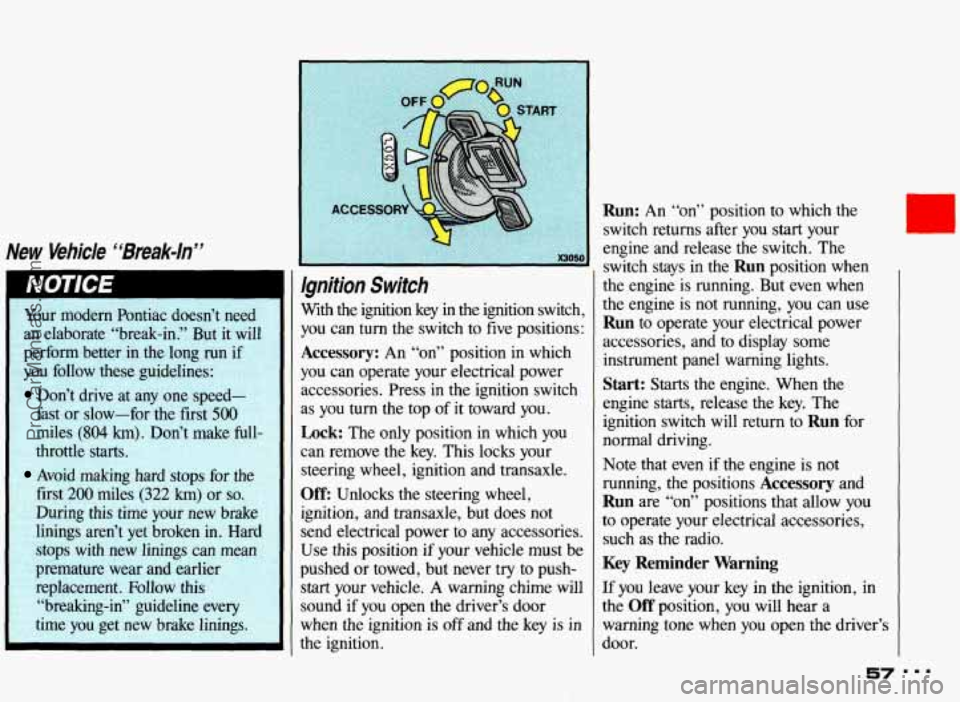
New Venice bbBreak-ln”
Your modern Pontiac doesn’t need
an elaborate “break-in.” But it will
perform better
in the long run if
you follow these guidelines:
Don’t drive at any one speed-
fast or slow-for the first
500
.miles (804 km). Don’t make full-
throttle
starts.
Avoid making hard stops for the
first 200 miles (322 km) or so.
During this time your new brake
linings aren’t yet broken in. Hard
stops
with new linings can mean
premature wear and earlier
replacement. Follow this “breaking-in” guideline every
time you get
new brake linings.
Ignition Switch
With the ignition key in the ignition switch,
you can turn the switch to five positions:
Accessory: An “on” position in which
you can operate your electrical power
accessories. Press in the ignition switch
as
you turn the top of it toward you.
Lock: The only position in which you
can remove the key. This locks your
steering wheel, ignition and transaxle.
Off: Unlocks the steering wheel,
ignition, and transaxle, but does not
send electrical power to any accessories.
Use this position if your vehicle must be
pushed or towed, but never try to push-
start your vehicle. A warning chime will
sound if you open the driver’s door
when the ignition is
off and the key is in
the ignition.
Run: An “on” position to which the
switch returns after you
start your
engine and release the switch. The
switch stays in the
Run position when
the engine is running. But even when
the engine is not running, you can use
Run to operate your electrical power
accessories, and to display some
instrument panel warning lights.
Start: Starts the engine. When the
engine starts, release the key. The
ignition switch will return to
Run for
normal driving.
Note that even if the engine
is not
running, the positions
Accessory and
Run are “on” positions that allow you
to operate your electrical accessories,
such as the radio.
Key Reminder Warning
If you leave your key in the ignition, in
the
Off position, you will hear a
warning tone when you open the driver’s
door.
57 ===
ProCarManuals.com
Page 75 of 322
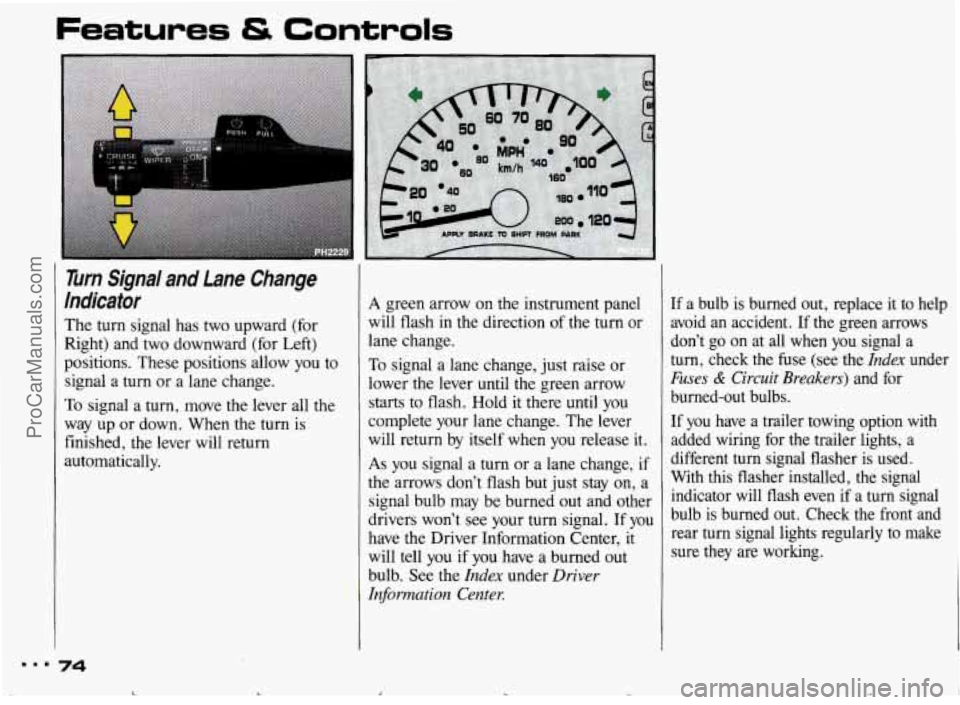
Features & Controls
Turn Signal and Lane Change
Indicator
The turn signal has two upward (for
Right) and two downward (for Left)
positions. These positions allow you to
signal a turn or a lane change.
To signal a turn, move the lever all the
way up or down. When the turn is
finished, the lever will return
automatically.
A green arrow on the instrument panel
will flash in the direction of the turn or
lane change.
To signal a lane change, just raise or
lower the lever until the green arrow
starts to flash. Hold it there until you
complete your lane change. The lever
will return by itself when you release
it.
As you signal a turn or a lane change, if
the arrows don’t flash but just stay
on, a
signal bulb may be burned out and other
drivers won’t see your turn signal.
If you
have the Driver Information Center, it
will tell you if you have a burned out
bulb. See the
Index under Driver
Information
Center.
If a bulb is burned out, replace it to help
avoid an accident.
If the green arrows
don’t go on at all when you signal a
turn, check the fuse (see the
Index under
Fuses & Circuit Breakers) and for
burned-out bulbs.
If you have a trailer towing option with
added wiring for the trailer lights, a
different
turn signal flasher is used.
With this flasher installed, the signal
indicator will flash even if a
turn signal
bulb is burned out. Check the front and
rear turn signal lights regularly to make
sure they are working.
... 74
.. c L ProCarManuals.com